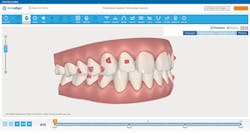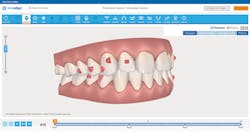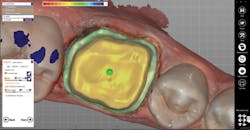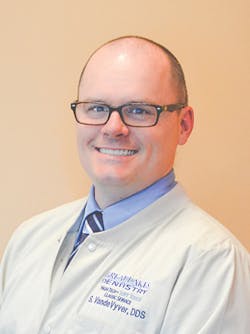Digital dentistry: Turning dental lab into dental CAD
Shawn Van de Vyver, DDS
It’s a long journey, my friend. I’m glad you’ve stuck with me this whole time on our digital dentistry road trip. I started out giving you the whole lay of the land and breaking down the entire excursion, beginning with digitizing your patient’s preoperative condition, to arriving at a finished restoration mostly untouched by human hands.
Along the way, I pointed out the landmark phases—specific digital counterparts to your analog workflow—such as acquisition, design, manufacture, and process. The first digital workflow systems marketed to dentists were all-inclusive turnkey packages designed to streamline the digital workflow and make it more efficient and user-friendly to deliver same-day digital dentistry in your office. Now, there are a few options to choose from, and they might not include every aspect of the digital workflow.
Put another way, not all of digital options are complete systems. You might only have an intraoral or desktop scanner so you can digitize your models and impressions, but where do you go from there? You can continue to send your scans to dental labs to complete the workflow, or you can take on some of that work yourself.
After acquiring your scan data and converting your impression to a digital STL file, you move into the design phase of the digital workflow. Just as there are multiple scanners to acquire the data, there are also multiple dental CAD, or computer-aided design, options out there. You may have even used some dental CAD software or services already and not even have been aware of it.
For example, even though the CEREC system is a complete digital workflow system, you can specify which CEREC CAD software you want to use with either the chairside module to design a single crown, or you can open the ortho software instead to digitize complete arches for digital orthodontic clear aligner treatment.
If you’ve used Invisalign services, you’ve used the ClinCheck CAD software to evaluate proposed treatment (figure 1). Other orthodontic software solutions include Exceed, Blue Sky Plan, ArchForm, Orchestrate 3D, and Maestro 3D, each with their own business models, software features, and user restrictions.
Figure 1: ClinCheck orthodontic CAD treatment simulation
In addition to simulating tooth movements and planning clear aligner treatment, orthodontic CAD programs also have the functionality to plan and place brackets for straight-wire treatment. Brackets can be placed on teeth virtually with precise alignment and angulation unattainable by hand, either on models or chairside.
For the general practitioner who may not offer orthodontic treatment, other dental CAD programs can design crown-and-bridge prostheses and even dental appliances. One program that has gotten more attention lately is called Exocad. Exocad can pretty much design any appliance or dental prosthesis you need, from simple single-unit crowns, to removable frameworks and complex multistructure full-arch hybrids.
As a general practitioner obsessed with wanting control over as many aspects of my treatment delivery as possible, one advantage I see with CAD programs is the option to dial in and tweak the design parameters (figure 2). Imagine a laboratory technician asking you on every case: “How much die spacer do you want? How far away from the margin do you want the spacer to start? What kind of cement gap would you like for this crown?” It would drive you nuts! On the other hand, you would have ultimate control over every aspect of your restorations. That’s the level of control and precision you can achieve when using a digital workflow.
Figure 2: Parameters for a single crown designed in Exocad (Scan courtesy of Kyle Shank, DDS)
The few drawbacks to the digital workflow are that you have to teach yourself the nuances of all these new, typically lab-responsible, parameters and allocate sufficient learning time to become more familiar with them and efficient in your workflow. It might take you just three minutes to write out a lab prescription, but on the first couple of tries with CAD, you may need 30 just to design a single unit. Not the best trade-off in the beginning.
These are only a few examples—a small taste—of the dental CAD software that is available. There are different programs that satisfy only a single or a few aspects of our daily practice. I use one program for planning an implant, another program to design the abutment and crown, and yet another program to design the bite splint that I’ll deliver after treatment. Oh yeah, and yet another program to manufacture the bite splint. Sounds confusing at first, but do you use just a single bur to prep a tooth, or do you utilize specialty tools and shapes to perform the specific task?
I’ve spent this short time talking about ways to get our patient data in to the computer and ways to design a restoration. Next time, I’ll talk a little bit about the different ways to get your designs out as a tangible prosthesis or appliance. Until then, stay thirsty for more from the #3DExpert.
Shawn Van de Vyver, DDS, a digital dentistry instructor, lectures with his company, V.I.P. Courses, on in-office milling and dental CAD. He is on the digital dentistry faculty of Dental Success Network, a member of the International Digital Dentistry Academy’s Restorative Appliance Committee, and creator of the online Exocad e-learning platform xocademy.com. His course schedule is available at vipdentalcourses.com, and you may contact him at [email protected].
Editor’s note:
This article is part of an occasional series on digital dentistry. Find previous articles on dentaleconomics.com. Search: Van de Vyver.



